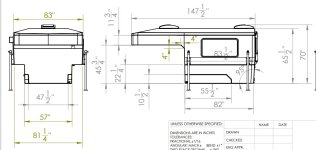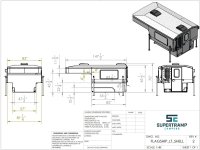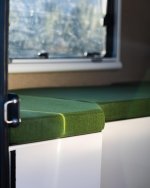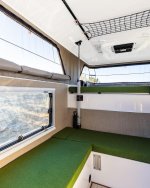Expedition Portal sent an email! Hoping that means their email woes have been resolved.
Yeah, it's the "what if" scenario that has kept me from being 100% sure about not optioning the Dometic A/C. Most of the reasons I outlined above are the internal thought process I've had with myself justifying why I'll be OK without it. Then that "what if" creeps in. I've watched those same videos about retrofitting a 12v A/C after the fact. After watching those, I've usually decided to just get the Dometic. Then a few weeks later, I decide against it again. On paper, for our use cases, all the cons outweigh the pros, but discomfort is a recipe for regret. One sweltering, horrible nights sleep may have me shouting at the sky "I'd pay $5,000 RIGHT NOW for A/C!" Ha. The portable units are week but like you mention, the latest Wave2 version is getting up there. For us, the main use of A/C would be taking the edge off the heat at night when trying to sleep. It's not about keeping the rig completely cool all day in 100F degree heat, or even 85 or 90. We just don't frequent temps like that, thought there are always flukes to deal with and, as mentioned above, in 10+ years, our used cases will change as we have more time to travel to more places. The decision may come down to the very last day that I'm able to decide final options and whatever mood strikes me that day.
For DC/DC charging, I agree more capability could be handy for larger batter banks. Once you go above 30amps, some chargers get a bit more bulky. Two 30amp chargers are smaller than some versions of 40 and 60 amp single chargers. Supertramp uses a unique cabling and routing for the pickup-to-camper run. Not sure if you took a look at the cables they use when you got the tour, but cabling consists of the two insulated cables that are formed within a thick rubber sheath. Not a coating or typical sheeth/coating, but an actual solid rubber tube. Will be very well protected from rubbing, etc.
If I recall correctly, the cabling is 8 gauge, which I thought was on the small side, but Keith said they got the full amperage from the 30amp charger. The cable run is a bit longer than on some other slide-in campers as it runs from the pickup battery all the way to the rear of the pickup bed where the plug is located. Then current will flow from that plug, into the camper then forward again to the DC charger in the electronic cabinet. Extra cabling and voltage drop aside, it will be a convenient location for the camper plug because you can plug/unplug with the camper on. Both of my previous campers had plugs near the front of the pickup bed and camper. The connectors could only be plugged/unplugged with the camper up on jacks and within a foot of the front of the pickup bed, so only during loading/unloading could the camper be plugged/unplugged. Of interest is our 2016 FWC install consisted of undersized 10 gauge wire and the voltage drop never gave the best DC charging. Our Overland Explorer CAMP-X install was with 6 gauge wire for the pickup and the camper, which is what REDARC requires from all camper manufacturers that install their REDARC battery manager.
(Note: Much of what I opine above and below you already know, but I'm going into a bit of extra detail for readers that don't).
For DC/DC chargers, another consideration is Alternator output. Many pickups have only one alternator and even with an optional factory upgrade, don't have the capacity to run 60+ amps worth of DC/DC chargers. Heavy Duty pickups with one huge alternator, multiple alternators or an aftermarket alternator do. If one is really into redundancy, an option would be running two separate 30amp DC/DC chargers each on their own independent circuits. Meaning, for a two alternator pickup, running one charger off one alternator/battery and the other charger off the second alternator/battery.
Sidebar: A Superduty with the optional Pro Power on board, like I ordered (still not sure if that was a good idea or not), comes with two alternators but one of them is 24volt! That alternator only runs the ProPower onboard inverter by first running current to two 12v batteries, wired in series, that sit right next to the inverter. In hindsight, I might have not opted for the Pro Power, still ordered with a second alternator, but that would have been 12v, and wired in my own 12v inverter. This would have allowed me to use that second alternator/battery for any 12v needs. Though Victron does make a 24v to 12v DC charger, those, like all DC chargers, are to be wired to, and draw from, a battery rather than wired direct to an alternator. And I don't know how the two 12v wired-in-series Pro Power batteries are situated and if I could tap into them for 24v current to power a 24to12v DC charger. And how I'd get that 24v into the camper to power the 24v to 12v DC charger. A second 12v alternator and battery would have been more flexible, but I didn't find out that the pro power alternator was 24v until after my Superduty order was locked in.
As for a second cable run, one would have to get that into the camper somehow. The stock camper plug/cabling likely is sized too small for anything larger than a 30amp DC charger, so that would mean either completely different camper wiring and pickup wire of larger gauge, but still use only one plug. If one wanted to run two separate circuits (one from each alternator), it would mean two pickup wiring runs, two pickup outlet, two camper plugs, and two cable runs in the camper to two DC chargers. Pros and cons to having two independent/redundant DC chargers or one larger cable run and DC charger. And you are right that a Supertramp designed/installed system would simplify all this for the owner. I suspect they would lean towards simply increasing the gauge of the one pickup wiring run, plug capacity, camper wiring, and increase the capacity of a single DC charger. (I mention the plug capacity because the one they use may or may not have the needed capacity for upsized cable gauge and upsized DC charger. I think Keith mentioned a trolling motor connector is used and most of those have 80amp plus capacity, so might be good).
Looking forward to seeing your rig. 40 days will fly by and it will be here before you know it. We are about 150 days out (5 months).
Regarding cabover length, the cabover length of the Supertramp is 65.5". My CAMP-X cabover length was 60.75".
Here is the CAMP-X, with 60.75" cabover, on my Tundra Double Cab (extended cab). Five more inches would be getting further up, but still not bad.

Here is the Supertramp, with 65.5" cabover, on a F150 Supercab (extended cab). The below F150 looks like a Thirteenth generation (2015–2020). The Fourth generation Super Duty (2017–2022) shared the same cab so this gives an good idea how the cabover length looks.

Not sure how the new Tundra extended cabs compare to the Ford extended cabs, but here is Hannah and Wesley's ( @thisistheway_adventures on instagram) new -body-style Tundra Double Cab (extended cab) with a Flagship.
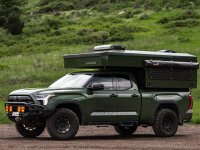
Regarding overall camper height when driving, here is an example-image of places we end up where a tall, hard wall camper could cause an issue. The new pickup and camper will be 6" taller than this rig (Tundra and CAMP-X). We'll be about 3" taller on camper and 3" taller on pickup bed height and that is without suspension lift, etc. that could come later. We would have made it through this particular section even if 6" taller, but it would have been tighter and slower.


